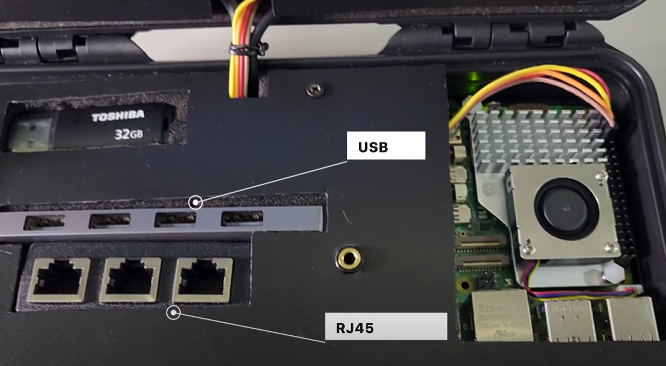This Raspberry Pi 5 cyberdeck is ready for doomsday

If there’s one community that’s ready for the apocalypse, it’s the Raspberry Pi community. You can hardly walk five feet without bumping your head on a really cool cyberdeck project. Now, we've come acrossa really cool Raspberry Pi 5 cyberdeck that was put together by a maker known as Raspduino Uno over at YouTube.
Raspduino Uno has affectionately dubbed the project PiDex. It’s got pretty much everything you might need in an emergency no-internet scenario. You can use it on the go thanks to its battery pack and even tap into a wealth of knowledge by storing information on the Pi with things like maps or notes survival skills.


The PiDex has a 32GB flash drive on hand that contains a copy of Wikipedia. This means you can access anything on Wikipedia even if you’re offline—or at the very least, you can access the information stored from your last backup. It’s fitted with an OLED screen to display stats about the Raspberry Pi, it has a toggle switch for power and the hardware is housed underneath a piece of binder that was carefully cut out and spruced up with a 3D-printed PiDex logo.
The main board is a Raspberry Pi 5. Everything is packed inside of an easy-to-carry waterproof box. The main display is a 7-inch touchscreen. It also has a mini backlit keyboard for input, a USB splitter and several Ethernet jacks, and a 3.5 mm headphone jack accessible on top for audio output. Raspduino Uno even threw in a switch to toggle for power.
You could theoretically run any OS you want with a setup like this. A popular first choice will almost always be the official Raspberry Pi OS. But you could easily branch out with other options and even keep them for backup on alternate microSD cards. Other good choices for a cyberdeck include Kali, Ubuntu and even RetroPie for gaming on the go.
If you want to get a closer look at this Raspberry Pi project, check out the official video shared to YouTube showing it off and be sure to follow Raspduino Uno for more cool projects.
Get Tom's Hardware's best news and in-depth reviews, straight to your inbox.

Ash Hill is a contributing writer for Tom's Hardware with a wealth of experience in the hobby electronics, 3D printing and PCs. She manages the Pi projects of the month and much of our daily Raspberry Pi reporting while also finding the best coupons and deals on all tech.
-
artk2219 Reply
While it looks neat, wouldn't get get more functionality out of an older laptop with replaceable batteries or one without a replaceable battery and you keep a battery bank or two in the case with it? Like a panasonic toughbook or a dell rugged, something along those lines.Admin said:Raspduino Uno is using a Raspberry Pi 5 to power their latest portable cyberdeck complete with a copy of Wikipedia’s database.
This Raspberry Pi 5 cyberdeck is ready for doomsday : Read more -
Medallish Reply
Tbh. I'm not impressed, I kinda expect more from someone who gets sponsored, and seems to have a channel focused on building stuff, but anyway.artk2219 said:While it looks neat, wouldn't get get more functionality out of an older laptop with replaceable batteries or one without a replaceable battery and you keep a battery bank or two in the case with it? Like a panasonic toughbook or a dell rugged, something along those lines.
I wanted to address the other point, as someone who's also building a survivalist Cyberdeck(Ultimately it's like a hobby so it doesn't have to be a survivalist thing), I used a Thinkpad X260 to explore the software aspects of what I wanted, and the laptop will do the job up to a point, some are better than others, but the thinkpad wouldn't let me use a 4g modem because it wasn't "whitelisted" in it's bios(I did check before, and to me it looked like it was supposed to work in it, but 🤷♂️), if any part was to break, I would have to pray I could find an identical computer.
My cyberdeck isn't public yet, but it's very much focused on being easily repairable/upgradeable. I don't know if it's going to actually going to look better than this guys', maybe if PCBway sponsors me :D. -
Treon s verdery I would also include the uncompressed text of all of the patents and patent images at the patent offices of the USA, European union, all european countries, Russia, Japan, South korea, Taiwan, Peoples republic of China, Australia, South Africa, Brazil, Ireland, all scandivian countries including Sweden, Norway, Denmark, and other Scandinavian countries, The Ukraine, Saudi Arabia, Iraq, Iran, and Israel. Also, a translation software program for all written languages, and a spoken language audio language software translation program. It is highly beneficial to have four separate power supply structures such as sockets, like two USB sockets, one USB C, One USB A, one all upward male prong Two conductor power supply connector, and one completely flat arrangement of 2-8 conductive, nonoxidizing, 2 mm thick metal pads of a silver color, where any two of all 8 pads being connected to DC or AC is circuit pathwayized to be a power supply, with any three pads making a tripartite -,+,ground or neutral attribute having power supply. That is because, to my perception, USB connectors sometimes get clogged or bent, so an array of planar pads gets around that. The 2mm thickness of the pads permits some abrasion, and repeated removal of muds, dirts, and gunks. The silver color reduces the likeliness of a yellow metal prompting recycling.Reply